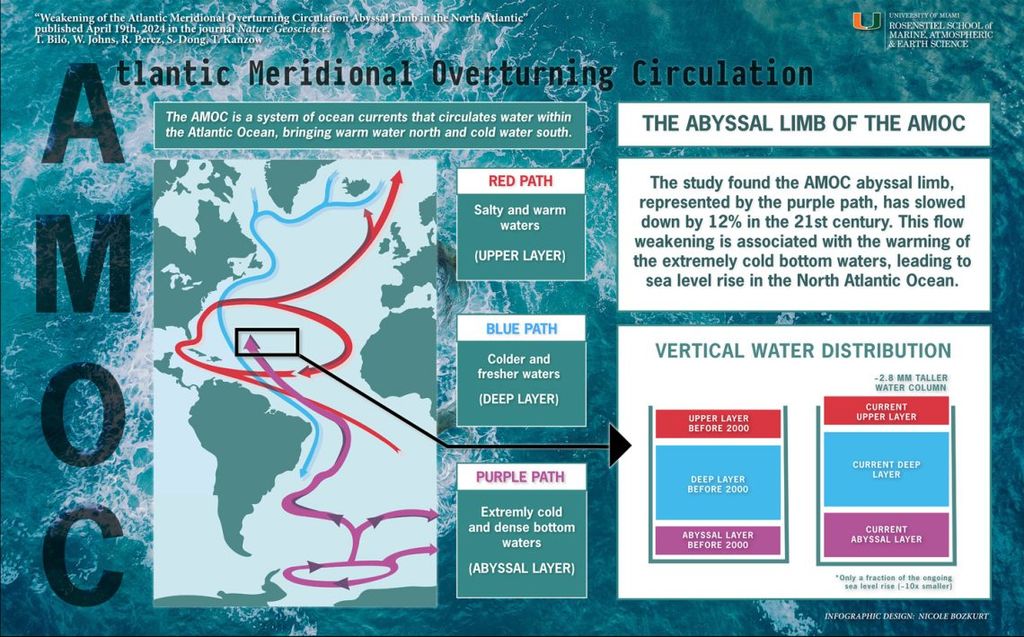Analysis of mooring observations and hydrographic data suggests that the deep-water branch of the Atlantic Meridional Overturning Circulation, AMOC, in the North Atlantic has weakened. Two decades of continuous observations provide a better understanding of the Earth’s climate regulation system.
But a study has just shown that warming of Antarctica’s deep waters is contributing to sea level rise in the North Atlantic.
Scientists examined data from several observational programs to study how a deep, dense, cold mass of water more than 4,000 meters below the ocean surface moves over time. This mass of water, which comes from the Southern Ocean, moves north and then rises to shallower depths in other ocean regions such as the North Atlantic.
What happens in Antarctic waters has repercussions in the North Atlantic.
A new study published in the journal Nature Geoscience, led by scientists at the University of Miami’s Rosenstiel School of Marine, Atmospheric and Earth Sciences and the National Oceanic and Atmospheric Administration’s Atlantic Oceanographic and Weather Laboratory, has revealed that human-induced environmental changes around Antarctica are contributing to sea level rise in the North Atlantic.
The research team analyzed two decades of deep-sea oceanographic data collected by mooring observation programs to show that a critical part of Earth’s global ocean current system in the North Atlantic has weakened ‘about 12% over the last two decades.

AMOC in the broader context of Atlantic currents. University of Miami
AMOC in the broader context of Atlantic currents. University of Miami
“Although these regions are tens of thousands of kilometers apart and the abyssal zones are only a few kilometers below the ocean surface, our results reinforce the idea that even the most distant zones remote areas of the world’s oceans are not untouched by human activity, » said study lead author Tiago Biló, an assistant scientist at NOAA’s Cooperative Institute for Marine and Atmospheric Studies at the school. Rosenstiel.
As part of the DeepT (Innovative Analysis of Deep and Abyssal Temperatures from Bottom Moored Instruments) project funded by NOAA, scientists analyzed data from several observation programs in order to study the evolution over time of a cold, dense body of deep water more than 4,000 meters below the ocean surface that flows northward from the Southern Ocean and eventually emerges at shallower depths in other parts of the world ocean, such as the North Atlantic.
AMOC at stake
This shrinking branch of the deep ocean, which scientists call the abyssal branch, is part of the Atlantic Meridional Overturning Circulation (AMOC), a three-dimensional system of ocean currents that acts as a « transmission belt » to distribute heat, nutrients and carbon dioxide in all the world’s oceans.
This near-bottom branch is composed of Antarctic bottom water, which forms from the cooling of seawater in the Southern Ocean around Antarctica during the winter months. Among the various mechanisms by which these bottom waters form, arguably the most important is brine release, a process that occurs when salt water freezes. When sea ice forms, it releases salt into the surrounding water, increasing its density. This dense water sinks to the ocean floor, creating a layer of dense, cold water that extends northward to fill all three ocean basins: the Indian Ocean, the Pacific Ocean, and the Atlantic Ocean.
NASA reveals critical map of fresh water reserves in Brazil and around the world! What does this map reveal?

NASA reveals critical map of fresh water reserves in Brazil and around the world! What does this map reveal?
During the 21st century, researchers observed that the flow of this Antarctic layer along latitude 16°N in the Atlantic had slowed, reducing the influx of cold water to higher latitudes and causing warming deep ocean waters.
“The areas affected by this warming extend thousands of kilometers in north-south and east-west directions, between 4,000 and 6,000 meters deep,” said co-author William Johns, professor of ocean sciences. at the Rosenstiel School. “This results in a significant increase in the heat content of the abyssal ocean, which contributes to local sea level rise due to thermal expansion of water.
Responsible human activity
“Our observational analysis agrees with what numerical models have predicted: human activity could impose circulation changes across the entire ocean,” Biló said. “This analysis was only possible thanks to decades of planning and collective efforts from multiple oceanographic institutions around the world.
The study, titled “Weakening of the abyssal branch of the Atlantic Meridional Circulation in the North Atlantic,” was published in the April 19, 2024 issue of the journal Nature Geoscience.




